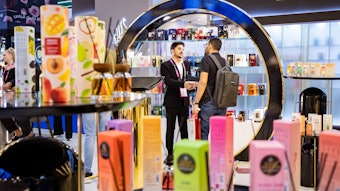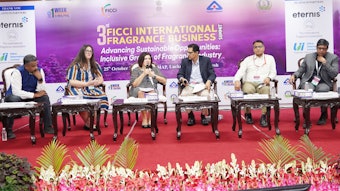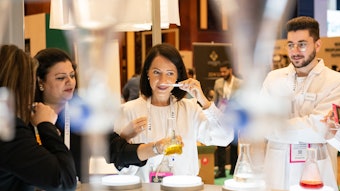
The International Exhibition of Raw Materials for Perfumery (SIMPPAR), held June 4 and 5 in Paris, allowed attendees to explore a wide range of ingredients and solutions for the fragrance industry. Across the show floor, I saw blotter sticks wafted under noses and observed so many conversations about new applications for these ingredients. The enthusiasm was contagious, and the spirit of innovation could be felt throughout the expo hall.
While I walked up and down the rows of booths, several trends immediately emerged that demonstrated the current direction of the fragrance industry. These trends have their own nuances, but they all relate to one macrotrend: sustainability. It’s not just a buzzword anymore; it is a necessity to ensure high-quality, cost-effective products that consumers will love.
I’ve compiled the top three trends from SIMPPAR 2025, each with their own examples of company applications. As this industry continues to evolve, I am excited to see how these trends will evolve as well at next year’s show. See you in Grasse!
Upcycling - What’s Old is New
 Givaudan presented attendees with a "scent piano" to sample different fragrances.Photo by Emily Little
Givaudan presented attendees with a "scent piano" to sample different fragrances.Photo by Emily Little
Sustainability is a key trend in the fragrance industry, with demand from both companies and consumers for more environmentally-friendly formulations. Ingredient suppliers are working to find ways to ensure their supply chains remain sustainable and reduce the impact on the natural environment.
Several companies included ingredients made from upcycled materials, showing how they can reduce their carbon footprint by using materials that would otherwise be thrown out. For example, Misitano & Stracuzzi, an Italian ingredients company known for its citrus ingredients, showcased its new banana ingredient, made using the leftover water from banana processing plants. Givaudan’s Apple Oil Orpur extracts its olfactive components from leftover apple juice pulp using the company’s proprietary technique.
We know that consumers are seeking more value in products, but formulators and suppliers want to get the most out of their materials, too. There is a clear benefit to using upcycled ingredients, both from a sustainable perspective and an economic one. After all, consumers say they would buy products made with sustainable ingredients.
Think Locally - Supporting Local Growers
 Synarome's display shows where each ingredient was sourced, emphasizing the importance of local sourcing. Photo by Emily Little
Synarome's display shows where each ingredient was sourced, emphasizing the importance of local sourcing. Photo by Emily Little
The raw materials used for perfumery applications have to be grown, and sourcing these materials locally is becoming increasingly important. Not only does this reduce shipping costs, but also supports farmers and local economies.
Distillerie Bleu Provence is a family-run business based in southeast France that works in collaboration with more than 200 farmers. This collaboration not only ensures that the company’s provencal essential oils are of the highest quality, but it also secures the activity of the farmers and supports sustainable practices. Additionally, Zalabi has created a nearly circular economy with its essential oil production, working directly with farmers to get the highest yields possible.
While several companies on the show floor operate at a global level, they are seeing the importance of ensuring their local farmers and supply chains are secure and sustainable. If the farmers are supported, the rest of the value chain will be, as well.
Trailblazers - Innovative Technologies
 MANE showcased several ingredients using its proprietary technology.Photo by Emily Little
MANE showcased several ingredients using its proprietary technology.Photo by Emily Little
In the vein of sustainability, ingredient manufacturers are also looking for new and innovative methods to create their products that are both cost effective and friendly to the planet. These include new processes in biotechnology and extraction to get the most yield and most authentic properties out of the material.
dsm-firmenich sampled ingredients using its Firgood technology. This technology uses electromagnetic waves targeted at the water molecules in the biomass to extract the olfactive elements of the material. The result is a natural and solvent-free extract, and the remaining biomass can either be upcycled or reused.
MANE also displayed its use of biotechnology in its Antillone, a tropical, fruity molecule derived from fatty acids. The ingredient is made through a patented fermentation process that uses no petrochemical solvents and minimal heating. This allows for a product purity level over 98%.
Every manufacturer I spoke to had the same concern: how do I get the most yield out of the raw material while keeping costs low. And I could see the creativity in these solutions, using science and technology to solve these issues. Why not leverage the power of microwaves or bacteria strains to innovate?










